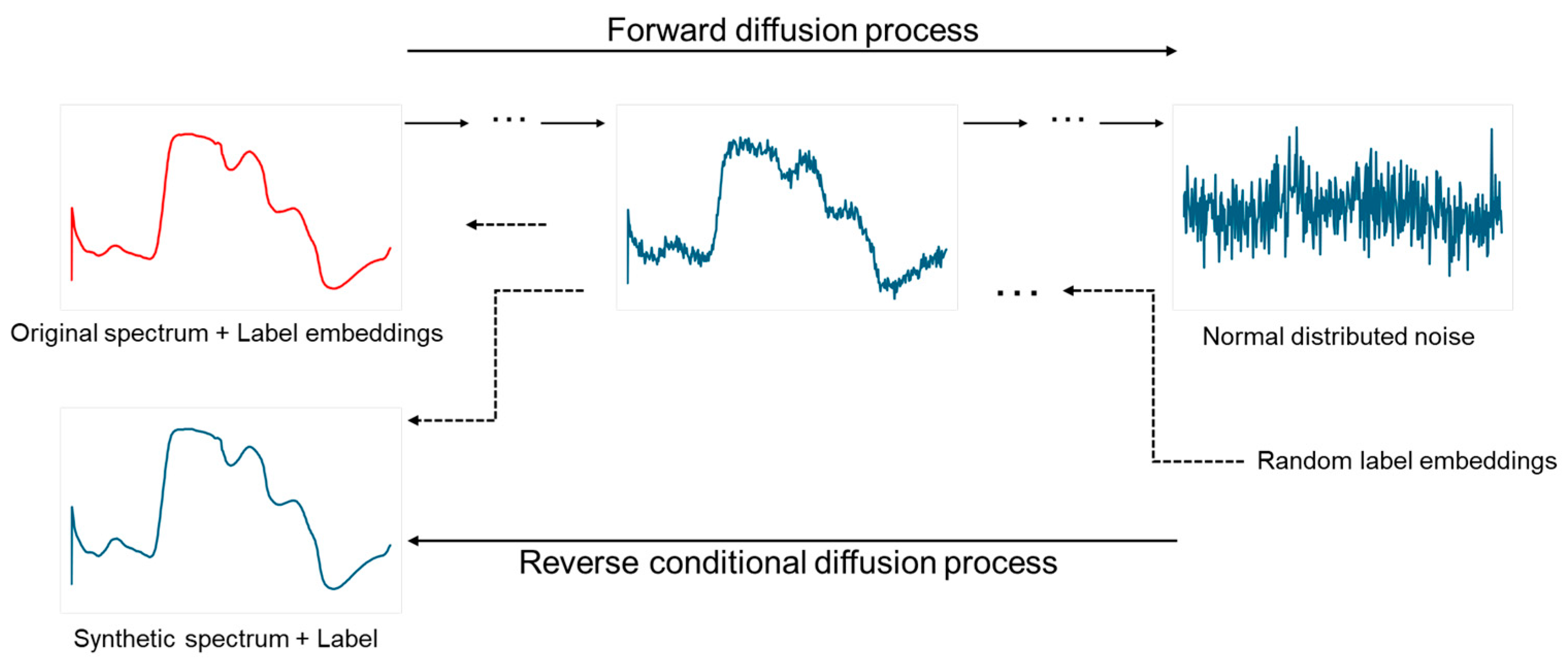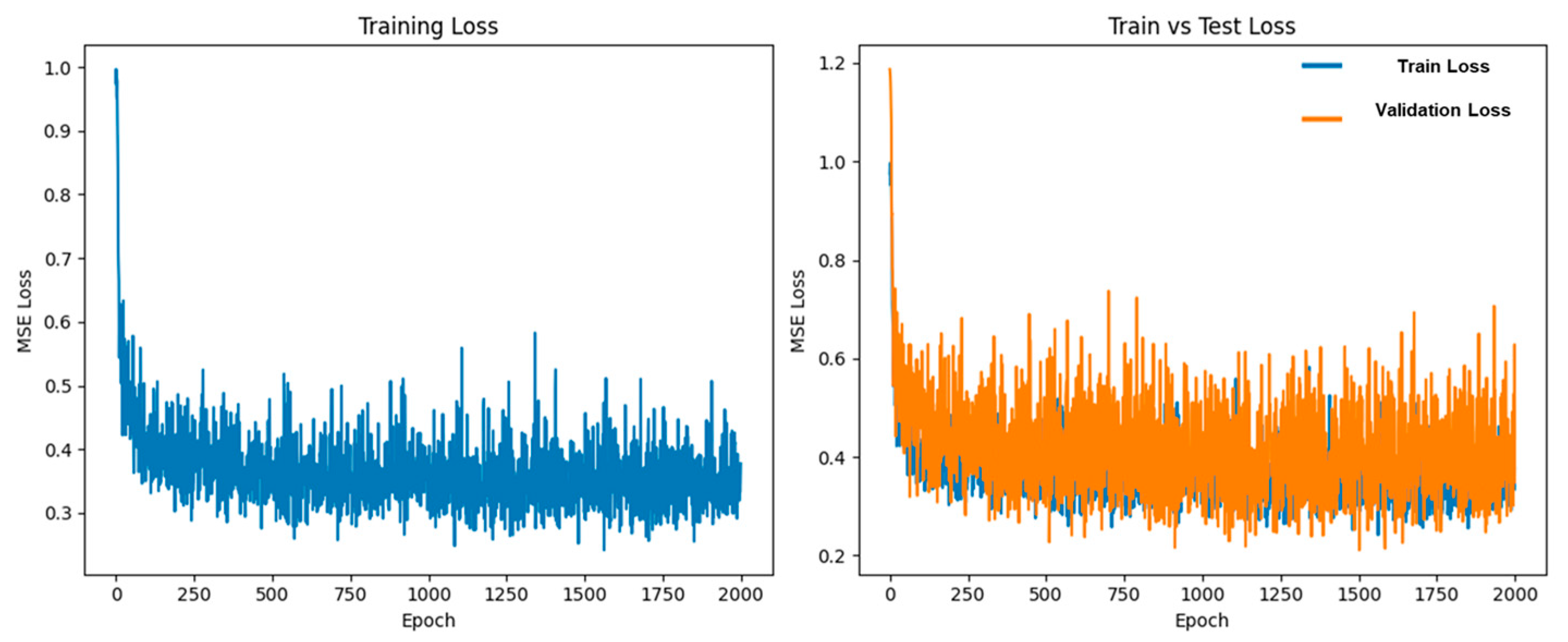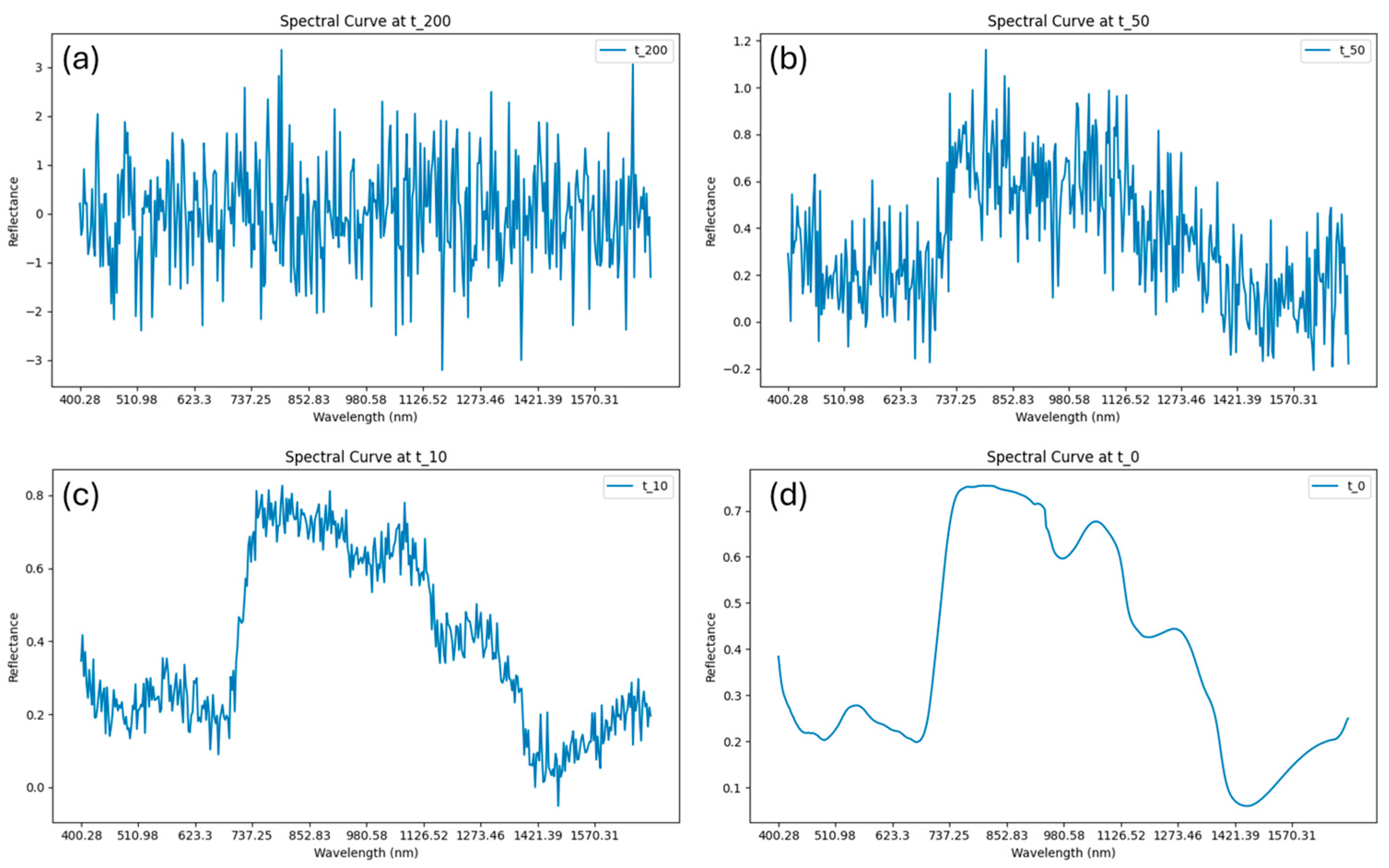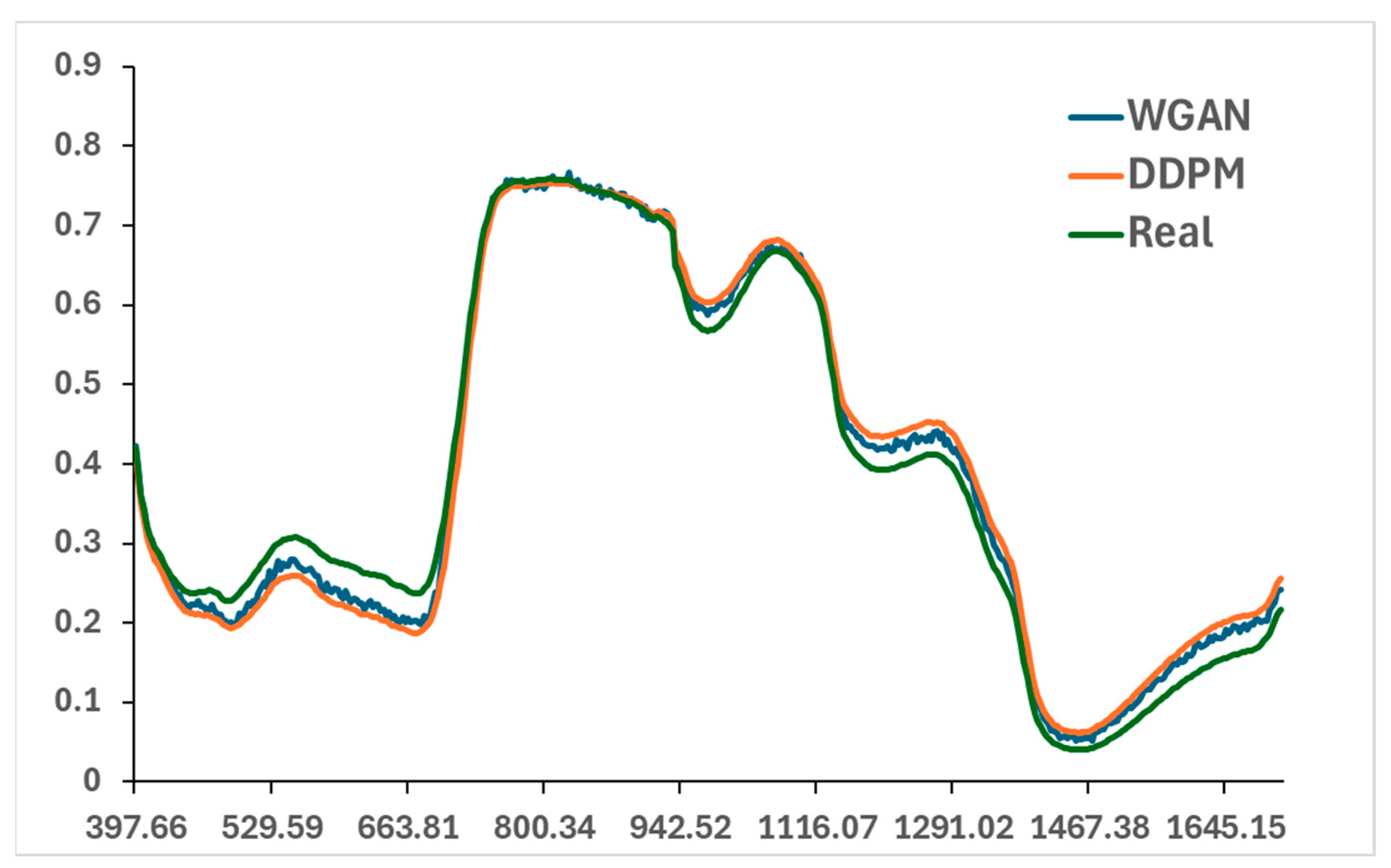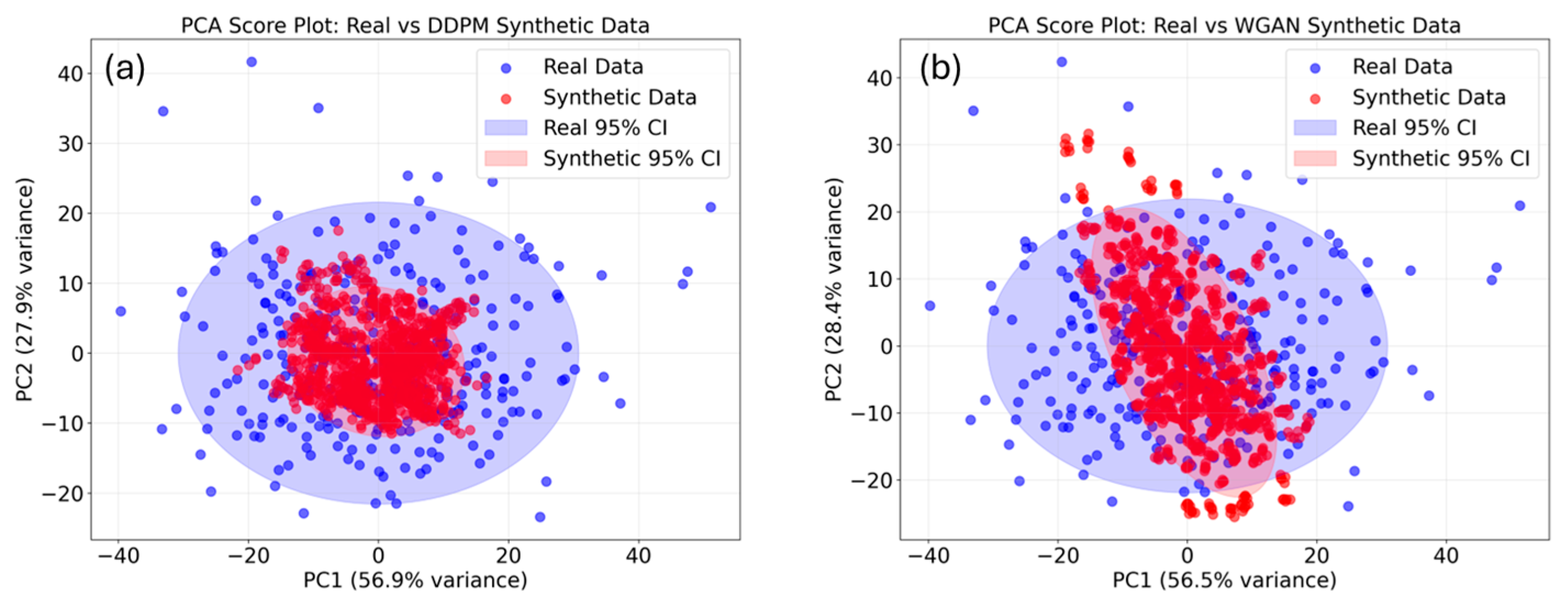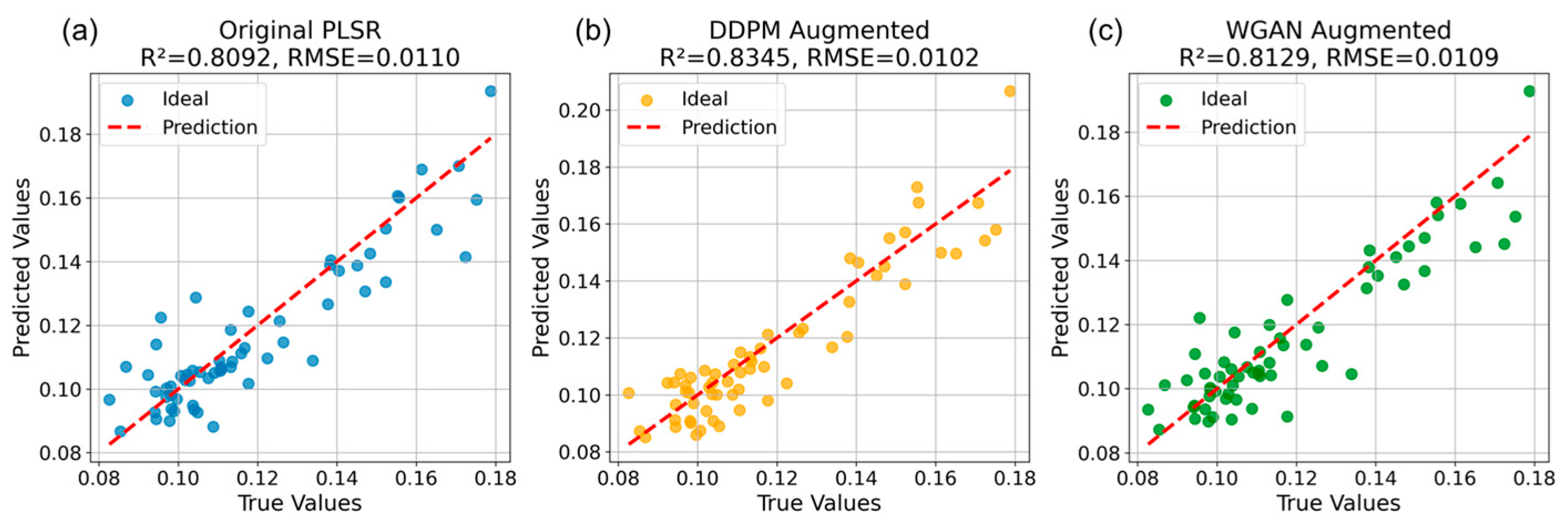1. Introduction
Near-infrared (NIR) spectroscopy has become a widely adopted analytical tool in agriculture for its advantages of being rapid, non-destructive, and cost-efficient once established [
1]. Applications span from monitoring crop quality and predicting chemical compositions such as moisture, protein, or sugar content, to supporting precision agriculture and postharvest management [
1,
2]. With the increasing demand for sustainable and data-driven solutions in agriculture, NIR spectroscopy is playing a critical role in bridging the gap between field-level observations and laboratory-based chemical analyses.
However, despite its promise, the effective utilization of NIR spectroscopy faces a fundamental challenge: the scarcity and cost of acquiring high-quality spectral datasets. Unlike conventional imaging, NIR measurements often require specialized instruments, controlled sampling protocols, and time-intensive calibration procedures [
3]. Moreover, the diversity of agricultural products and environmental conditions further increases the need for large and representative datasets [
4]. In practice, the limited availability of labeled NIR spectra often constrains the robustness of machine learning models, leading to overfitting and reduced generalization ability in real-world scenarios [
5].
To address data scarcity, various strategies have been explored. Traditional data augmentation techniques—such as spectral shifting, scaling, or noise injection—introduce limited variability and may not accurately reflect realistic spectral patterns [
6]. More advanced generative models, such as Variational Autoencoders (VAEs) and Generative Adversarial Networks (GANs), have shown potential in synthesizing realistic data. For example, researchers have demonstrated that training GANs on limited Vis–NIR datasets allows the synthesis of additional spectra that effectively improve nutrient prediction models for soils under challenging field conditions [
7]. Similarly, in viticulture studies, synthetic NIR hyperspectral data generated by GANs has been shown to capture maturity-related spectral variations, thereby enhancing the robustness of grape quality assessment [
8]. In addition, researchers developed a conditional VAE (CVAE) framework to guide spectral data augmentation for calibration modeling in in situ measurements. In this approach, the CVAE is trained to generate virtual spectra that expand the training dataset, while a semi-supervised ladder network (S2-LN) regression model leverages both generated and real spectra. These studies highlight the capacity of GANs and VAE to expand dataset diversity while preserving meaningful chemical and structural information embedded in NIR and hyperspectral signals. However, both GAN and VAE suffer from drawbacks such as mode collapse, training instability, and difficulties in capturing fine-grained spectral structures. As a result, there is a growing demand for more powerful generative frameworks capable of producing high-fidelity synthetic spectra that can augment limited datasets [
9,
10].
Denoising Diffusion Probabilistic Models (DDPMs) have recently emerged as a new class of generative models that demonstrate state-of-the-art performance in image and audio [
11]. For example, researchers used a stable diffusion model as an image augmentation method to synthesize multi-class weed images to improve the weed detection performance [
9]. Unlike GANs, diffusion models are based on a gradual denoising process that transforms Gaussian noise into realistic data samples, ensuring both stability and diversity in generation [
12]. Their probabilistic framework allows for better coverage of the underlying data distribution, making them particularly attractive for scientific domains where data realism and variability are critical. Beyond image augmentation, diffusion-based frameworks have also been explored for tabular data generation, demonstrating their ability to model heterogeneous features and complex data distributions in industrial and biomedical datasets [
13].
However, near-infrared (NIR) spectroscopy data pose unique challenges compared to conventional tabular datasets. NIR spectra are high-dimensional, highly correlated, and physically constrained by molecular absorption mechanisms. Unlike typical tabular data, where features are independent or weakly correlated, NIR signals exhibit smooth and structured variations across wavelengths, and small distortions may significantly affect their interpretability. Consequently, directly applying diffusion models designed for unstructured tabular data may not fully capture the intrinsic spectral continuity and domain-specific characteristics of NIR measurements. This motivates our investigation into adapting DDPMs for agricultural NIR data augmentation, aiming to exploit their generative power while preserving the underlying physical and chemical information inherent in spectral data.
The main contributions of this study are twofold: (1) we propose, for the first time, a diffusion-based framework for augmenting agricultural NIR spectroscopy data, and (2) we conduct a systematic evaluation of generated spectra in terms of both statistical similarity and downstream predictive performance.
2. Materials and Methods
2.1. NIR Dataset
In this study, NIR spectral data were obtained from the publicly available SpectroFood dataset, which contains hyperspectral measurements and corresponding dry matter measurements for leek. The leek samples were captured using a dual-camera setup consisting of the Specim FX10 (398–931 nm) and Specim FX17 (936–1717 nm) (Specim, Oulu, Finland), providing a combined spectral range from 398 to 1717 nm with a total of 421 spectral bands. The full width at half maximum (FWHM) ranged from 2.62 to 3.58 nm, and the sample–camera distance was maintained at 60 cm to minimize illumination variability. A total of 288 leek samples were included in this subset, each associated with a measured dry matter content (DMC).
All hyperspectral data in the SpectroFood dataset were preprocessed by the data providers to correct for radiometric and reflectance distortions using the standard white–dark reference calibration:
where
is the raw hyperspectral measurement,
is the white reference image,
is the dark reference, and
is the calibrated reflectance value.
After calibration, dead pixels and spikes were removed using fixed thresholding, and non-sample background regions were excluded using manual segmentation [
14]. The resulting dataset thus consists of 288 samples × 421 wavelengths, each paired with its corresponding dry matter measurement, forming the basis for subsequent diffusion-based data augmentation and predictive modeling.
2.2. Diffusion Model
To address the limited availability of near-infrared (NIR) spectral data in agricultural research, we employed a denoising diffusion probabilistic model (DDPM) implemented with a lightweight multilayer perceptron (MLP) architecture. Unlike image-based diffusion models, which rely on convolutional networks, our approach adopts a fully connected network tailored for one-dimensional spectral vectors, enabling efficient generation of realistic NIR spectra conditioned on dry matter content.
2.2.1. Model Architecture
The diffusion framework follows the standard forward–reverse denoising process (
Figure 1), where Gaussian noise is progressively added to the clean spectral data
over a predefined number of timesteps
. The corrupted spectrum at step
is defined as follows:
where
, and
are linearly spaced noise variance parameters.
The goal of the denoising model is to learn the reverse mapping
, conditioned on the target variable
. The denoising network is an MLP, denoted as
, which predicts the clean spectral signal
given the noisy input and timestep embedding. The input to the model is the concatenation of
and noisy spectrum
. The network consists of several fully connected layers with dropout regularization, implemented as follows:
2.2.2. Training Objective
The denoising network was trained to minimize the mean squared error (MSE) between the predicted clean spectrum and the original uncorrupted input:
2.2.3. Conditional Sampling
During inference, the trained MLP-Diffusion model generates synthetic spectra via a deterministic DDIM sampling process. Given a desired target variable
, random noise is gradually denoised through
reverse steps to yield the generated spectrum
:
where
(0, I). This conditional generation mechanism allows the creation of synthetic NIR spectra corresponding to specific chemical or physical properties, effectively augmenting the training dataset for downstream regression tasks.
Synthetic spectra were generated by sampling across the full range of observed DMC values, ensuring that the augmented dataset adequately covers the calibration space of interest. The number of synthetic samples per DMC value was chosen to provide sufficient variability while remaining computationally feasible. This conditioning mechanism enables the DDPM to produce spectra that are not only realistic in shape but also consistent with the associated chemical property.
2.2.4. Model Training
The NIR dataset of leek samples was first randomly divided into training and testing subsets with an 8:2 ratio. This splitting procedure was repeated three times using different random seeds to better assess the robustness of the results. The testing subset was reserved exclusively for downstream regression tasks to evaluate the predictive performance of generated spectra with real samples. Within the 80% training portion, the data were further split into training and validation sets (7:3) for optimizing the diffusion model and preventing overfitting. The MLP-based denoising diffusion model (DDPM) was implemented using PyTorch 2.8 and trained on an NVIDIA RTX 4060 GPU. Model optimization was performed using the Adam optimizer with a cosine annealing learning rate schedule. The main hyperparameters, including network depth, hidden dimensions, number of diffusion steps, dropout rate, and learning rate, are summarized in
Table 1. The best-performing DDPM used the following settings: learning rate = 0.001, batch size = 512, diffusion timesteps = 500, training iterations = 2000, number of MLP layers = 4, and MLP nodes per layer = 256.
During training, the model progressively learned to reconstruct clean spectral features from noisy inputs, minimizing the mean squared error (MSE) between the reconstructed and original spectra. The best-performing checkpoint, based on validation loss, was saved for subsequent conditional sampling and data augmentation experiments.
2.3. Conditional Wasserstein Generative Adversarial Network
To provide a comparative baseline for evaluating the performance of the diffusion-based approach, a Conditional Wasserstein Generative Adversarial Network (WGAN) was implemented for NIR data generation. The WGAN consists of a generator, a discriminator, and an auxiliary classifier that are jointly trained in an adversarial and conditional learning setup. The generator is designed to synthesize realistic NIR spectra conditioned on specific dry matter content (DMC) values, thereby capturing the underlying relationship between spectral variation and physicochemical properties. The discriminator learns to differentiate between real and synthetic spectra, encouraging the generator to produce more physically plausible outputs. Meanwhile, the classifier enforces the conditional constraint by ensuring that the generated spectra are not only visually and statistically realistic but also consistent with their target DMC values.
The generator, discriminator and classifier were implemented as fully connected multilayer perceptrons (MLPs) with leaky rectified linear unit (ReLU) activation functions and layer normalization to enhance stability. The WGAN model was trained using the same 80% training subset of the leek dataset employed for DDPM training, with a batch size of 64, learning rate of 1 × 10−4.
The WGAN-generated spectra were later compared with DDPM-generated data in terms of visual spectral consistency, distributional similarity, and downstream regression performance. This comparison provides a clear evaluation of the relative merits of diffusion-based versus adversarial-based generative frameworks for NIR data augmentation.
2.4. Evaluation of DDPM and WGAN
To comprehensively assess the quality and realism of the synthetic NIR spectra generated by the DDPM and WGAN models, multiple quantitative and visual evaluation metrics were employed. The Spectral Angle Mapper (SAM) score was used to measure the angular difference between synthetic and real spectra, providing an index of spectral similarity that is invariant to illumination intensity. Cosine similarity was additionally computed to quantify the alignment of spectral vectors, serving as a complementary measure to SAM. The Root Mean Square Error (RMSE) between synthetic and reference spectra was calculated to evaluate absolute spectral reconstruction accuracy. Furthermore, the Maximum Mean Discrepancy (MMD) with a radial basis function (RBF) kernel was applied to assess the overall distributional similarity between real and generated data in a high-dimensional feature space. To facilitate visual comparison of spectral distributions, Principal Component Analysis (PCA) was performed on the combined real and synthetic datasets, enabling inspection of how closely the generated samples aligned with the real data manifold in the reduced feature space. Together, these metrics provide a robust multi-perspective evaluation of spectral fidelity, structural consistency, and diversity of the synthetic datasets produced by both generative models.
2.5. Machine Learning Model Evaluation
To evaluate the quality of the synthetic NIR spectra generated by the DDPM and WGAN, this study adopted a downstream regression task using DMC as the target variable. The underlying assumption is that models trained on high-quality synthetic and real data should be competitive with models only trained on real data. Therefore, two experiments were conducted: (1) using only the original training dataset, and (2) using the original training dataset plus DDPM or WGAN synthetic dataset. Three regression algorithms with complementary learning mechanisms were adopted: Partial Least Squares Regression (PLSR), Random Forest (RF), and XGBoost. PLSR was selected for its strong interpretability and suitability for high-dimensional, collinear spectral data [
15]; RF served as a non-linear ensemble baseline with robustness to noise and overfitting [
14]; and XGBoost, a gradient boosting algorithm, provided an advanced non-linear modeling framework capable of capturing complex spectral–chemical relationships [
16].
Model performance was evaluated on the 20% hold-out test set, which was never used during diffusion model training or augmentation, ensuring an unbiased evaluation. The predictive accuracy was quantified using the coefficient of determination (R
2) and root mean square error (RMSE):
where
is the number of samples used to fit the model,
is the ground truth value of the
th sample,
is the model estimated value of the
th sample, and
is the mean response value.
4. Discussion
The results demonstrate that the proposed DDPM-based framework can effectively generate realistic NIR spectra and improve regression performance in downstream prediction tasks. Compared with traditional generative methods such as generative adversarial networks (GANs) and variational autoencoders (VAEs), diffusion probabilistic models exhibit superior stability and fidelity in reproducing the intrinsic variability of NIR spectra. Previous studies have reported that GAN-based spectral data augmentation could enhance soil nutrient estimation and fruit quality prediction, yet these methods often suffer from mode collapse and limited diversity in generated samples, particularly when the available training data are scarce [
7,
17,
18,
19]. Similarly, VAE-based approaches, while capable of learning latent spectral distributions, tend to produce overly smoothed spectra that lack fine-grained reflectance variations critical for accurate regression modeling [
20,
21].
In this study, we quantitatively compared DDPM with WGAN in generating synthetic NIR spectra. During training, WGAN proved more difficult to fit and required careful tuning to avoid instability. While WGAN-generated spectra generally preserved the overall spectral shape and trends, they exhibited higher noise levels compared with DDPM-generated spectra (
Figure 7). The diffusion model adopted in this study provides a more stable generative process by explicitly modeling noise addition and denoising steps (
Table 2,
Figure 8). The iterative denoising mechanism allows the model to reconstruct spectral signatures that preserve both local smoothness and global spectral shape, yielding synthetic spectra that closely follow the real data distribution. As shown in
Table 3, all three regression models—PLSR, RF, and XGBoost—achieved improved predictive performance when trained on the DDPM-augmented dataset compared with the original training set and the WGAN-augmented dataset. This suggests that the synthetic samples contribute meaningful spectral variability, helping to regularize the model and prevent overfitting, especially under data-scarce conditions typical in agricultural datasets [
22].
The improvement observed in PLSR performance is particularly noteworthy, since linear models are more sensitive to spectral variability and noise. The enhanced accuracy after augmentation indicates that the diffusion-generated spectra effectively enriched the calibration space while maintaining realistic correlations between spectral patterns and dry matter content. This aligns with recent findings in other fields where DDPM-based augmentation was shown to outperform GANs in terms of data fidelity and downstream prediction accuracy [
13]. Regarding DDPM architecture, a simple MLP was employed due to its computational efficiency. Despite its simplicity, the MLP-DDPM effectively captured spectral continuity and fine-grained absorption features, as evidenced by the close alignment with real spectra and downstream regression performance. However, statistical analysis using paired
t-tests showed that the gains achieved by the MLP-based DDPM were not statistically significant (
p = 0.17 for R
2 and
p = 0.19 for RMSE), indicating that although DDPM-generated spectra contributed meaningful variability and tended to enhance model performance, the improvement was not sufficient to reach statistical significance in this study. Future studies need to explore using more complex architectures, such as 1-D convolutional networks or transformers, to enhance the capacity to model local and long-range spectral dependencies, which could be explored in future work.
Overall, the results confirm the potential of diffusion probabilistic models as a robust approach for spectral data augmentation. By learning the underlying data manifold through gradual denoising, DDPMs can generate realistic and diverse synthetic samples without requiring adversarial optimization or complex latent regularization. To further strengthen this work, future studies could perform ablation analyses, such as varying the number of generated samples, diffusion steps, or conditioning variables, to systematically assess the robustness of results, identify optimal hyperparameters, and extend comparisons with VAEs and other GAN variants. While smaller or larger numbers of synthetic samples were not exhaustively tested in this study, this represents a potential avenue for future work, where systematic exploration of the optimal number of generated spectra could help maximize downstream regression performance and further improve calibration-space coverage.
5. Conclusions
This study presents a novel application of denoising diffusion probabilistic models (DDPMs) for NIR spectral data augmentation in agricultural analysis. Using the SpectraFood leek dataset as a case study, the DDPM successfully learned the underlying spectral distribution and generated realistic synthetic spectra conditioned on dry matter content. The inclusion of these synthetic samples in the training dataset improved the predictive performance of three regression models—PLSR, RF, and XGBoost—highlighting the potential of diffusion-based generative modeling to mitigate data scarcity in spectroscopy-driven agricultural research.
Compared with conventional generative frameworks such as WGAN, the diffusion-based approach demonstrated higher stability and data fidelity, effectively expanding the calibration space without introducing unrealistic noise. This makes DDPM particularly suitable for small-sample or domain-limited agricultural spectroscopy tasks, where obtaining large numbers of labeled samples is costly and time-consuming.
Future work will focus on extending the proposed framework to conditional and hybrid diffusion architectures, integrating environmental and physiological covariates to guide spectral generation more precisely. Additionally, exploring cross-domain generalization—for instance, transferring learned spectral priors from one crop type to another—may further enhance the practicality of DDPMs for broader agricultural sensing applications. The combination of diffusion-based generative modeling and precision agriculture analytics thus holds promise for improving model robustness, interpretability, and scalability in data-limited real-world scenarios.
